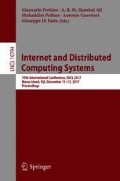Abstract
With the increasing frequency of traffic accidents, traffic safety has attracted attention of the researchers. Most of the traffic accidents are related to the driver’s risky behavior or some improper driving habits, such as leaning against the window/door, picking up things, or looking backwards when driving at high speed. In this paper, to detect such risky behaviors, we propose a decision tree for classification that recognizes four kinds of driving behaviors: normal driving, looking backwards, leaning against the window and picking up things. A time series of pressure data were measured from a mat with 2 × 2 pressure sensors which are distributed on the driver seat. Regarding the preprocessing phase, a digital filter is used for noise reduction. Results show that our method can achieve an average recognition rate of 88.25%.
Access this chapter
Tax calculation will be finalised at checkout
Purchases are for personal use only
References
Global status report on road safety: World Health Organization. http://www.who.int/violence_injury_prevention/road_safety_status/2015/en/
Sun, S., Wu, Q., Chai, C., et al.: A driving posture prediction method based on driver comfort. In: International Conference on Computer-Aided Industrial Design and Conceptual Design, pp. 1–5. IEEE (2006)
Kim, D.Y., Bang, J.H., Lee, C.A., et al.: Numerical evaluation of time-dependent sagging for low density polyurethane foams to apply the long-term driving comfort on the seat cushion design. Int. J. Ind. Ergon. 64, 178–187 (2017)
Su, C., Chu, Z.: Research on driving posture comfort based on relation between drivers’ joint angles and joint torques. SAE Int. J. Commercial Veh. 7, 45–49 (2014). (2014-01-0460)
Yan, C., Coenen, F., Zhang, B.: Driving posture recognition by convolutional neural networks. IET Comput. Vis. 10(2), 103–114 (2016)
Yamada, T., Irie, H., Sakai, S.: High-accuracy joint position estimation and posture detection system for driving. In: Adjunct Proceedings of the 13th International Conference on Mobile and Ubiquitous Systems: Computing Networking and Services, pp. 219–224. ACM (2016)
Yan, S., Teng, Y., Smith, J.S., et al.: Driver behavior recognition based on deep convolutional neural networks. In: International Conference on Natural Computation, Fuzzy Systems and Knowledge Discovery, pp. 636–641. IEEE (2016)
Wang, Y.K., Chen, S.A., Lin, C.T.: An EEG-based brain–computer interface for dual task driving detection. Neurocomputing 129, 85–93 (2014)
Ling, Z., Lu, X., Wang, Y., Zhou, Y., Wang, G., Li, J.: Local sparse representation for driver drowsiness expression recognition. In: Chinese Automation Congress (CAC) 2013, pp. 733–737 (2013)
Lee, B.-G., Chung, W.-Y.: Wearable glove-type driver stress detection using a motion sensor. In: IEEE Transactions on Intelligent Transportation Systems, vol. 18, pp. 1835–1844 (2017). ISSN 1524-9050
Huang, M., Gibson, I., Yang, R.: Smart chair for monitoring of sitting behavior. KnE Eng. 2(2), 274–280 (2017)
Xu, W., Huang, M.C., Amini, N., et al.: ecushion: A textile pressure sensor array design and calibration for sitting posture analysis. IEEE Sens. J. 13(10), 3926–3934 (2013)
Suzuki, S., Kudo, M., Nakamura, A.: Sitting posture diagnosis using a pressure sensor mat. In: IEEE International Conference on Identity, Security and Behavior Analysis (ISBA), 2016, pp. 1–6. IEEE (2016)
Ma, C., Li, W., Gravina, R., et al.: Posture detection based on smart cushion for wheelchair users. Sensors 17(4), 719 (2017)
Ma, C., Li, W., Gravina, R., et al.: Activity recognition and monitoring for smart wheelchair users. In: IEEE, International Conference on Computer Supported Cooperative Work in Design, pp. 664–669. IEEE (2016)
Ma, C., Li, W., Cao, J., Wang, S., Wu, L.: A fatigue detect system based on activity recognition. In: Fortino, G., Di Fatta, G., Li, W., Ochoa, S., Cuzzocrea, A., Pathan, M. (eds.) IDCS 2014. LNCS, vol. 8729, pp. 303–311. Springer, Cham (2014). https://doi.org/10.1007/978-3-319-11692-1_26
Ma, C., Li, W., Cao, J., Gravina, R., Fortino, G.: Cloud-based wheelchair assist system for mobility impaired individuals. In: Li, W., et al. (eds.) IDCS 2016. LNCS, vol. 9864, pp. 107–118. Springer, Cham (2016). https://doi.org/10.1007/978-3-319-45940-0_10
Fsr406 Website. http://www.interlinkelectronics.com/force.php
Aissaoui, R., Kauffmann, C., Dansereau, J., et al.: Analysis of pressure distribution at the body–seat interface in able-bodied and paraplegic subjects using a deformable active contour algorithm. Med. Eng. Phys. 23(6), 359–367 (2001)
Fisher, S.V., Patterson, P.: Long term pressure recordings under the ischial tuberosities of tetraplegics. Spinal Cord 21(2), 99–106 (1983)
Bush, C.A.: Study of pressures on skin under ischial tuberosities and thighs during sitting. Arch. Phys. Med. Rehabil. 50(4), 207–213 (1969)
Liu, C., Qiu, Y., Griffin, M.J.: Dynamic forces over the interface between a seated human body and a rigid seat during vertical whole-body vibration. J. Biomech. (2017)
Chen, K.H., Chiueh, T.D.: A low-power digit-based reconfigurable FIR filter. IEEE Trans. Cir. Syst. II Express Briefs 53(8), 617–621 (2006)
Mohanty, B.K., Meher, P.K.: A high-performance FIR filter architecture for fixed and reconfigurable applications. IEEE Trans. Very Large Scale Integr. (VLSI) Syst. 24(2), 444–452 (2016)
Estrada, J.E., Vea, L.A.: Real-time human sitting posture detection using mobile devices. In: Region 10 Symposium (TENSYMP), 2016 IEEE, pp. 140–144. IEEE (2016)
Heyer, P., Herrera-Vega, J., Rosado, D.-E.N.V., Enrique Sucar, L., Orihuela-Espina, F.: Posture based detection of attention in human computer interaction. In: Klette, R., Rivera, M., Satoh, S. (eds.) PSIVT 2013. LNCS, vol. 8333, pp. 220–229. Springer, Heidelberg (2014). https://doi.org/10.1007/978-3-642-53842-1_19
Acknowledgements
This paper has been funded by the National Natural Science Foundation of China (No.71672137, 61571336) and China-Italy S&T Cooperation project “Smart Personal Mobility Systems for Human Disabilities in Future Smart Cities” (China-side Project ID: 2015DFG12210). This work has been also carried out under the framework of INTER-IoT, Research and Innovation action - Horizon 2020 European Project, Grant Agreement #687283, financed by the EU.
Author information
Authors and Affiliations
Corresponding author
Editor information
Editors and Affiliations
Rights and permissions
Copyright information
© 2018 Springer Nature Switzerland AG
About this paper
Cite this paper
Yang, Z., Yu, M., Li, W., Ma, C., Gravina, R., Fortino, G. (2018). Risk Driving Behaviors Detection Using Pressure Cushion. In: Fortino, G., Ali, A., Pathan, M., Guerrieri, A., Di Fatta, G. (eds) Internet and Distributed Computing Systems. IDCS 2017. Lecture Notes in Computer Science(), vol 10794. Springer, Cham. https://doi.org/10.1007/978-3-319-97795-9_15
Download citation
DOI: https://doi.org/10.1007/978-3-319-97795-9_15
Published:
Publisher Name: Springer, Cham
Print ISBN: 978-3-319-97794-2
Online ISBN: 978-3-319-97795-9
eBook Packages: Computer ScienceComputer Science (R0)

